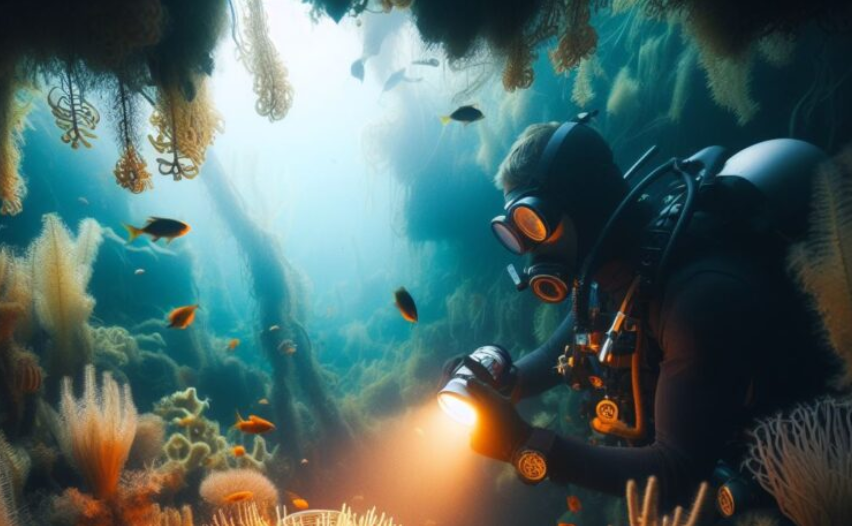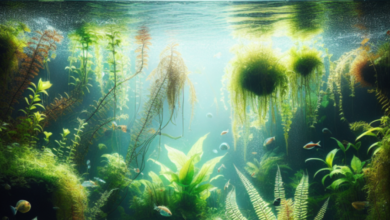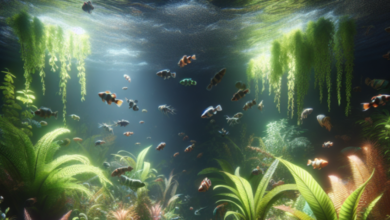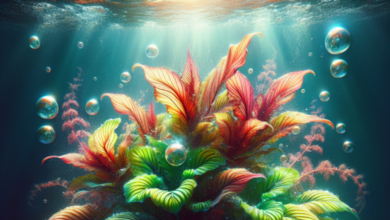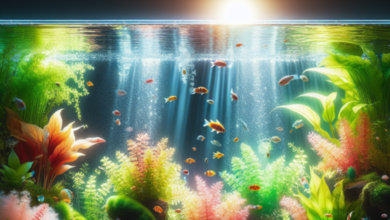The Atlantic Ocean, with its vast expanse covering approximately 41 million square miles, offers a rich and diverse range of marine flora species, each playing an essential role in the oceanic plant life and overall aquatic ecosystems.
From the tiniest phytoplankton responsible for generating half of the planet’s oxygen, to the towering underwater kelp forests, marine biology in the Atlantic has woven an intricate tapestry that sustains the ocean’s rich biodiversity. Dive with us as we explore the vibrant world of underwater plants residing in the Atlantic Ocean and discover their importance in the world’s natural balance.
Key Takeaways
- Atlantic Ocean vegetation provides a diverse array of plant species instrumental in the functioning of aquatic ecosystems.
- Phytoplankton populating the marine environment generate a significant portion of Earth’s oxygen supply.
- Marine flora species, ranging from microscopic organisms to massive plants, form the basis for Atlantic Ocean’s marine food chain.
- Underwater plants play a crucial role in climate patterns and the health of marine species.
- Kelp forests, home to diverse marine life, contribute to the richness of Atlantic Ocean biodiversity.
Introduction to Atlantic Ocean Flora
Spanning the vast waters and depths of the Atlantic Ocean lies a rich and astonishing world of plant life, laying the foundation of thriving marine ecosystems. These aquatic species connect ecosystems from coastal shores to the open ocean and reach down to the darkest abyss.
The Atlantic Ocean ecosystem encompasses a remarkable range of marine plants, supporting crucial functions in the health, productivity, and stability of the underwater environment. This section aims to provide an introductory overview of the oceanic flora diversity found within the Atlantic, setting the stage for a deeper exploration of their fascinating roles and interactions.
Characterized by size, shape, and function, the marine plants of the Atlantic can be broadly classified into several categories:
- Microscopic Phytoplankton
- Macrophytes and Seaweeds
- Floating Plants
- Submerged and Emergent Flowering Plants
The most minute members of the Atlantic flora, phytoplankton are microscopic single-celled algae that drift along with the ocean’s currents. Although tiny, they contribute significantly to the world’s oxygen through photosynthesis, securing their role as essential organisms in marine food webs.
Among the ocean’s more notable inhabitants are the seaweeds and macrophytes, which include several large and geographically diverse oceanic flora, such as kelp forests, seagrass meadows, and coral reefs. As primary producers, these marine plants supply both food and habitat to a vast array of aquatic species.
The unique floating plants of the Atlantic offer yet another layer of diversity, such as the floating sargassum seaweed found in the Sargasso Sea. These plants create specific microenvironments, serving as living oases in the open ocean for various aquatic species.
Finally, the submerged and emergent flowering plants provide crucial connection points between terrestrial and marine ecosystems, with coastal species like mangroves and salt marshes providing vital services, such as shoreline protection and nursery grounds for marine life.
Taking a broader view of the Atlantic Ocean ecosystem, the diversity of oceanic flora highlights the intricate web of relationships and dependencies that drive marine life. As we delve deeper into the world of marine plants, it becomes clear that the vibrant underwater communities of the Atlantic Ocean are a spectacle to behold and appreciate.
The Unique Ecosystem of the Atlantic Ocean
The Atlantic Ocean’s ecosystem is influenced by various factors such as ocean currents, salinity, and sunlight. These components determine the types of plant life found at different depths in the ocean, shaping the way marine ecosystems function. In this section, we will explore the role of these key factors in supporting the diverse flora species in the Atlantic Ocean.
The Role of Ocean Currents
Ocean currents have a significant impact on the distribution of flora across the Atlantic Ocean. They help transport nutrients and organisms throughout the ocean, influencing plant growth and reproduction. For example, the Gulf Stream—a swift and powerful warm-water current—moves warm waters from the Gulf of Mexico to the North Atlantic, creating favorable conditions for various plant species like seagrasses and phytoplankton. This demonstrates the importance of ocean currents in maintaining healthy and diverse marine ecosystems in the Atlantic Ocean.
Salinity and Plant Adaptation
Plant species in the Atlantic Ocean exhibit a wide range of saline tolerance to survive in their varying underwater surroundings. Some plants, such as mangroves and seagrasses, have evolved specialized adaptations like salt excretion and salt filtration to thrive in saline environments. Others, like certain types of macroalgae, possess the ability to regulate their internal salt concentrations to adjust to fluctuating conditions. These adaptations are crucial in facilitating the survival and growth of plant life in different regions of the Atlantic Ocean, directly impacting the overall health and biodiversity of marine ecosystems.
Depth Zones and Sunlight Penetration
The penetration of sunlight into the ocean affects the distribution of plant species in the Atlantic. The ocean is divided into the photic zone and the aphotic zone based on the amount of sunlight available. The photic zone, where sunlight reaches, is conducive for plant growth due to the availability of light for photosynthesis. Especially, phytoplankton and seaweeds such as kelp are abundant in the photic zone. On the other hand, the aphotic zone is characterized by darkness and receives minimal to no sunlight. Nevertheless, some plants and organisms have adapted to survive in these low-light conditions, like red algae, which can grow at significant depths thanks to their ability to absorb blue-green light more efficiently. This distinction in depth zones highlights the varied and dynamic ecosystems supported by the Atlantic Ocean.
Plants in the Atlantic Ocean: A Diverse Habitat
The Atlantic Ocean is teeming with a vast array of marine plant habitats, supporting unique ecosystems that contribute to the aquatic biodiversity of the region. From sunlit surface waters to mysterious depths, each zone offers distinct environments that host diverse oceanic flora species. In this section, we will explore these flora habitats and how plants in the Atlantic Ocean provide shelter and breeding grounds for marine creatures, ensuring the balance of this rich and vibrant ecosystem.
At the surface, the sunlit layer of the ocean, known as the euphotic zone, is home to free-floating phytoplankton. These microscopic plants form the foundation of the marine food chain and produce much of the Earth’s oxygen. In turn, phytoplankton support zooplankton and various filter feeders, creating a thriving habitat full of biodiversity.
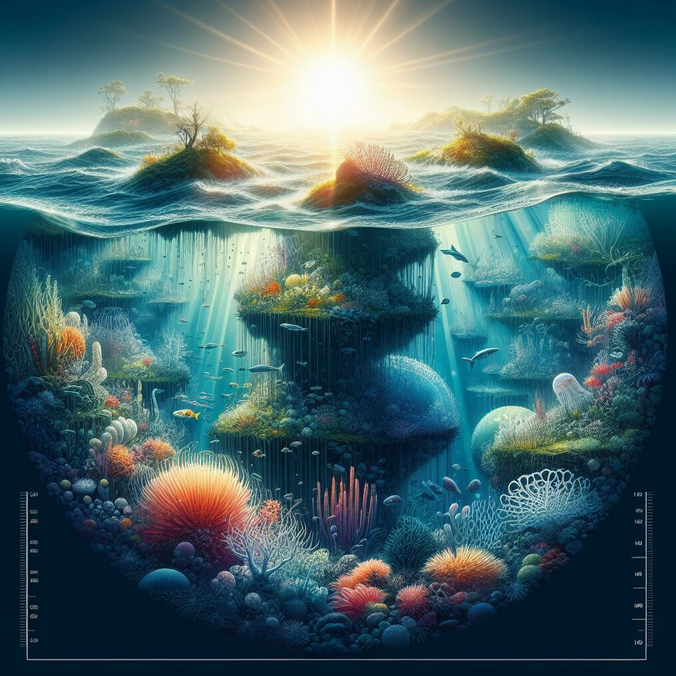
Moving into deeper waters, we find seaweeds like kelp and other macroalgae that thrive in the sublittoral zone. Kelp forests, which can grow 150 feet tall, create intricate underwater habitats that house marine species such as fish, invertebrates, and marine mammals. These underwater forests are essential to the fauna residing in these habitats while also stabilizing sediments and protecting coastlines from erosion.
Seagrass beds, commonly found in shallow coastal waters, offer diverse and productive habitats for various marine organisms, including fish, crustaceans, and sea turtles
Seagrass beds, commonly found in shallow coastal waters, offer diverse and productive habitats for various marine organisms, including fish, crustaceans, and sea turtles. These underwater meadows not only provide essential feeding and breeding grounds but also improve water quality by reducing excess nutrient levels and controlling erosion with their extensive root systems.
At greater depths, species of red and green algae thrive in the dim light, adapted to lower levels of sunlight penetration. These algae provide shelter and food for numerous deep-sea organisms and support the survival of various marine creatures in these challenging environments.
Overall, the diverse habitats created by plant life in the Atlantic Ocean play a critical role in maintaining the balance and health of these ecosystems. Each unique environment supports countless marine species and significantly contributes to the aquatic biodiversity in the Atlantic. Recognizing and protecting the numerous plant habitats in this extraordinary ocean will ensure their vital role in sustaining marine life for generations to come.
Seaweeds: The Foundation of Marine Botany
As integral components of the Atlantic Ocean’s marine botany, seaweeds from the red, brown, and green algae families play pivotal roles in supporting the diverse marine life in the area. In this section, we explore the unique characteristics of these primary producers and their importance in maintaining the health of the Atlantic Ocean’s ecosystem.
Red Algae: Rhythms of the Atlantic
Renowned for their distinctive hues, red algae is an important group of marine algae as they thrive at significant depths, thanks to their ability to absorb blue light. These Atlantic seaweed species contribute to reef building and carbon sequestration, thereby providing crucial habitats for marine species and food for various creatures. Some red algae species also produce valuable compounds used in the food and cosmetic industries, reflecting their remarkable versatility.
Brown Algae: The Giants of the Sea
Brown algae, part of the macroalgae family, are easily recognizable due to their massive size. These underwater giants create extensive forests that offer critical habitats and nourishment for a wide range of marine life. Notably, kelps—large brown algae species—are important in maintaining biodiversity in the Atlantic Ocean as they provide food, shelter, and breeding grounds for various organisms, including fish, crustaceans, and mollusks. Brown algae also play a vital role in the global carbon cycle by sequestering significant amounts of carbon dioxide from the atmosphere.
Green Algae: The Unknown Champions
Often under-studied, green algae are the overlooked heroes in the family of marine algae. These versatile algae can be found in both shallow and deep waters, fulfilling vital ecological roles, including oxygen production through photosynthesis and contributing to nutrient cycling. Green algae support diverse aquatic communities by offering habitats and food for both microscopic and larger organisms. As primary producers, green algae hold immense importance within the food web, forming the base of countless marine systems in the Atlantic Ocean.
In conclusion, red, brown, and green seaweeds form the foundation of marine botany, providing indispensable support to the Atlantic Ocean’s intricate ecosystems. Their ecological roles, from primary production to habitat formation, underscore their significance in sustaining the ocean’s biodiversity and overall health. By understanding their functions and contributions, we appreciate the value of these remarkable algae and the need to conserve their presence in our unique marine environments.
The Sargasso Sea and its Unique Flora
The Sargasso Sea, an enigmatic region in the North Atlantic Ocean, is surrounded by four major ocean currents that keep it relatively isolated. This unique area is characterized by its floating plant life, particularly sargassum, a genus of brown seaweed with air-filled bladders, allowing it to effortlessly float on the surface.
This remarkable floating seaweed serves as the foundation for the Sargasso Sea’s diverse marine ecosystems. Dense mats of sargassum support a variety of marine species, such as juvenile sea turtles and various fish, which take shelter and find nourishment within the tangled fronds. As such, sargassum creates a microcosm teeming with life within the larger Atlantic Ocean.
The Sargasso Sea serves as a crucial spawning ground for several species and is a vital component of the ocean’s health.
The Sargasso Sea’s unique flora attracts a diverse range of organisms, from the tiniest plankton to larger marine animals. For instance, multiple species of eels rely on the Sargasso Sea as a breeding ground, with their larvae drifting on the ocean currents for thousands of miles before reaching their future habitats. In addition to these fascinating ecological roles, sargassum helps to capture CO2 from the atmosphere, contributing to the overall health of the world’s oceans.
Despite the ecological value of the floating seaweed communities, the Sargasso Sea faces some challenges. Warming ocean waters, plastic pollution, and increased volume of sargassum due to nutrient-rich runoff from land-based activities threaten the unique ecosystems and the organisms that call them home. Recognition and preservation of the Sargasso Sea and its extraordinary flora are essential to maintain the balance within the Atlantic Ocean and safeguard the health of countless marine species.
Mangroves: The Coastal Protectors
Mangroves play a crucial role in the Atlantic Ocean’s coastal ecosystems, offering vital shoreline protection and serving as marine nurseries for numerous aquatic species. These salt-tolerant trees exhibit unique adaptations that enable them to thrive in these challenging environments. This section delves into the distribution and types of mangroves along the Atlantic coastline while highlighting their ecological importance.
Mangrove Distribution and Types
Atlantic Ocean mangroves are found predominantly in the subtropical and tropical regions, extending from the coastal areas of the southeastern United States down through Central America, the Caribbean, and northern South America. There are several species of mangroves, each with its distinctive characteristics and adaptations to survive in saline environments. Key species found in these regions include the red mangrove (Rhizophora mangle), black mangrove (Avicennia germinans), white mangrove (Laguncularia racemosa), and buttonwood mangrove (Conocarpus erectus).
The Ecological Importance of Mangroves
Mangroves offer numerous ecological benefits to both coastal and marine ecosystems. Their intricate root systems provide a secure and fertile breeding ground for various marine species, functioning as vital marine nurseries. This includes supporting commercially and ecologically important fish, crustaceans, and mollusks. Furthermore, these root systems trap sediment, ensuring a healthy seagrass population and protecting coral reefs from smothering by accumulated debris.
As coastal protectors, mangroves serve as a natural buffer against coastal erosion, storm surges, and wave action. Their root systems stabilize shorelines and can mitigate the impacts of coastal flooding and rising sea levels. Moreover, mangrove forests sequester large amounts of carbon, contributing to climate change mitigation by reducing greenhouse gas emissions.
Despite their ecological significance, mangroves face numerous threats such as deforestation, coastal development, and climate change. Ensuring their conservation is crucial for maintaining the health and resilience of the Atlantic Ocean’s coastal and marine ecosystems.
Coral Reefs: Rainforests of the Ocean
Atlantic coral reefs are often referred to as the rainforests of the ocean, due to their role as marine biodiversity hotspots. These vibrant ecosystems depend on the intricate symbiotic relationships between coral polyps and algae, which create the foundation for reef-building corals.
Coral Polyps and Algal Symbiosis
Within Atlantic coral reefs, the mutualism between coral polyps and algae is vital to their survival. These symbiotic relationships involve the microscopic algae, also known as zooxanthellae, which reside within the tissues of coral polyps. Through photosynthesis, the algae provide essential food and oxygen for the corals, while in return, the corals provide the algae with a protected home and access to sunlight for continued photosynthesis.
Zooxanthellae are the microscopic algae which reside within the tissues of coral polyps, providing them with food and oxygen through photosynthesis.
The Colorful World of Coral Reefs
Atlantic coral reefs are teeming with life and color, providing a home to various marine species. The abundance of reef-building corals contributes to the structure and complexity of these underwater systems, creating unique habitats that support a diverse array of organisms.
| Common Coral Species | Color | Role in the Reef |
|---|---|---|
| Brain Coral | Brown | Provides shelter and contributes to reef formation |
| Elkhorn Coral | Tan or Brown | Forms a framework for other species to colonize and thrive |
| Sea Fan | Purple, Red, or Yellow | Filters water and provides a habitat for various marine life |
Protecting our planet’s marine biodiversity hotspots, such as Atlantic coral reefs, is essential to preserving the delicate balance of life both above and below the ocean’s surface. Through understanding and appreciating the importance of these colorful ecosystems, we can work together to ensure their conservation for the future.
Conclusion
In conclusion, the conservation of Atlantic Ocean flora plays a vital role in preserving the numerous aquatic ecosystems and marine life that thrive within the Atlantic Ocean’s vast waters. From the microscopic phytoplankton to the majestic kelp forests, each plant species carries an essential ecological function, supporting marine biodiversity as well as influencing global climate patterns. As we look towards a future focused on sustainable oceans, understanding the importance of the Atlantic’s marine flora is key to forming comprehensive strategies for protecting these underwater communities.
Environmental stewardship extends beyond our immediate surroundings and into the vast expanse of our oceans. By acknowledging the threats that human activities pose to these fragile ecosystems, we become more informed advocates for the protection and preservation of the Atlantic Ocean flora. From plastic pollution to climate change, various factors jeopardize the health and survival of these precious ecosystems. Each global citizen holds a shared responsibility in maintaining the delicate balance of these environments and ensuring a marine flora future that thrives for generations to come.
As we continue to uncover more about the fascinating world of Atlantic Ocean flora, it’s crucial to support and implement conservation efforts aimed at fostering healthy and resilient marine ecosystems. By recognizing the importance that these underwater plants hold in both aquatic realms and our own well-being, we take a step towards a brighter, sustainable future for our planet’s oceans.
FAQ
What types of plants can be found in the Atlantic Ocean?
The Atlantic Ocean hosts a diverse range of plant life, including microscopic phytoplankton, various seaweeds (red, brown, and green algae), mangroves, and coral reefs. These plants contribute significantly to the overall health of marine ecosystems and the biodiversity of the ocean.
How do ocean currents affect the distribution of Atlantic Ocean flora?
Ocean currents transport nutrients and organisms, influencing patterns of plant distribution. They create movement of water masses and determine different environmental and oceanographic conditions that plants need to thrive, resulting in varied plant life across the Atlantic Ocean.
How do ocean depths and sunlight penetration affect plant growth in the Atlantic?
Light penetration in the ocean determines the viable growth environment for various plants. In the photic zone, where sunlight reaches, photosynthesis can occur, whereas in the aphotic zone, darkness prevails, limiting plant growth to species that can survive with minimal light or no photosynthesis.
What is the ecological significance of seaweeds in the Atlantic Ocean?
Seaweeds, including red, brown, and green algae, play pivotal roles as primary producers of organic matter and oxygen, sustaining various marine life directly or indirectly. They create essential habitats and provide food for marine creatures, making them vital for maintaining biodiversity and the overall health of marine ecosystems.
How do mangrove forests contribute to coastal and marine ecosystems?
Mangrove forests protect shorelines from erosion and storm surges, maintain water quality by trapping sediments and nutrients, and serve as nurseries for numerous aquatic species. They contribute to the overall health and resilience of coastal and marine ecosystems along the Atlantic coastlines.
What is the relationship between coral polyps and algae in a coral reef ecosystem?
Coral polyps and algae share a mutualistic symbiotic relationship. The algae, living within the coral polyps, produce food through photosynthesis, which the coral polyps utilize. In return, the corals offer the algae a protective environment and the necessary nutrients to thrive, allowing for the creation of vibrant coral reef ecosystems.
Why is it important to conserve and protect the flora of the Atlantic Ocean?
The conservation of Atlantic Ocean flora is crucial for maintaining the health and diversity of marine ecosystems, which impacts everything from climate patterns to the wellbeing of marine species. By protecting these valuable habitats and implementing sustainable practices, we ensure the survival and resilience of ocean ecosystems for future generations.
